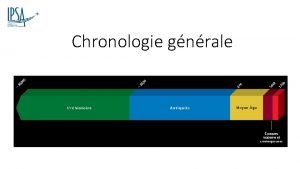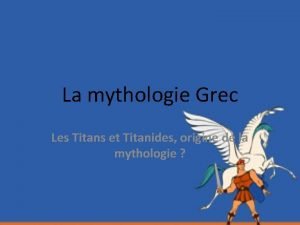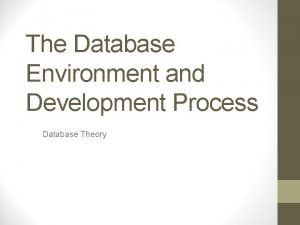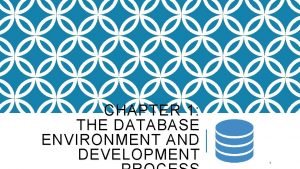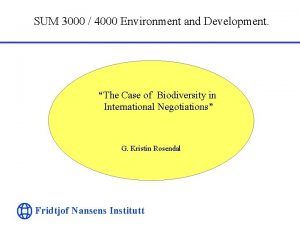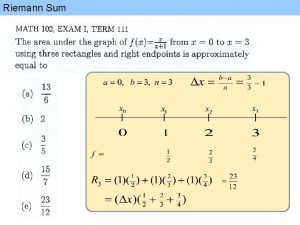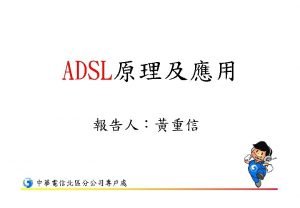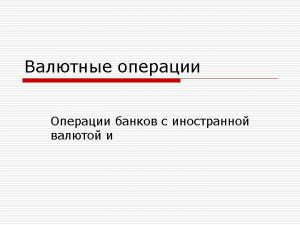SUM 3000 4000 Environment and Development The Case















- Slides: 15

SUM 3000 / 4000 Environment and Development. “The Case of Biodiversity in International Negotiations” G. Kristin Rosendal Fridtjof Nansens Institutt

1. Overview of presentation • The issue: Loss and value of biodiversity • Main focus: Agreed but diverging objectives – Convention on Biological Diversity (CBD) objectives: Balance conservation, access and benefit sharing – TRIPS and WIPO objective: Stimulate innovation – FAO objective: Access to breeding material • Implementing diverging objectives: Two theoretical perspectives Fridtjof Nansens Institutt

2. Relevance • Protection: Breeders and bioprospectors need legal protection (intellectual property rights) of genetic material to assure a fair return from investments in genetic improvement. • Access: Farmers, breeders and bioprospectors need access to genetic resources for food and medicine production and genetic improvement • Conservation: Biodiversity is threatened and there is a need for models of incentives for conservation • How to balance protection & access - and stimulate innovation and conservation? Fridtjof Nansens Institutt

3. Biodiversity: Ecosystems, species, genes • Loss of biodiversity: – Loss is 100 times faster than ’natural average rate’ – Of the 7 -60 mill. species world-wide; only 1. 9 mill. scientifically described: Do not know what is being lost • Increased attention on value of biodiversity: – U. S. biotechnology generates US$ 13 billion yearly – loss deprive people of ecosystem services worth about US$250 billion yearly – Non-economic: Intrinsic and cultural value • Rapid loss + High value = Political focus Fridtjof Nansens Institutt

4. Economic value of genetic diversity • Agriculture and animal breeding: – Depend on access to diversity of genetic material to retain high yield, adapt to changes and resist diseases • Medicinal potential: Bioprospecting – Less than 1 % of all plants, insects, marine and microbiological organisms has been examined for chemical traits – 80% rely on herbal medicines & traditional knowledge about their use – OECD: yearly value of products derived from genetic resources estimated at 500 - 800 billion US$ Fridtjof Nansens Institutt

5. CBD: International negotiations • Science and politics: Consensus • From conservation to equity: Conflict – 1970 s: Ramsar, CMS, CITES. 19902: CBD • The conflict in the CBD negotiations: – 1. Main bulk of terrestrial species found in tropical areas – 2. Genetic resources: Input factors for biotechnology – 3. Biotechnological inventions building on traditional knowledge and seeds collected from tropical areas – 4. Privatisation & patents also within life sciences – 5. Patents hardly applicable in developing countries: Rosy periwinkle – International agreement: Balance access to genetic resources and equitable sharing of benefits Fridtjof Nansens Institutt

6. Establishment of the CBD • Contents of CBD: Some highlights – Into force 1993: 188 Parties (- USA and Iraq) – Three main objectives: 1. Conservation of biodiversity, 2. sustainable use of biodiversity, 3. equitable sharing of benefits from use of genetic resources – Compromise: National sovereignty to balance free access and patent protection – Conservation: Reverse loss by 2010 Fridtjof Nansens Institutt

7. Establishment of the Bonn Guidelines • CBD Bonn Guidelines (2002): – Prior informed consent and mutually agreed terms – Material Transfer Agreement: Document conditions – Participation of all stakeholders (8 j) – Claim for information about access and country of origin in patent application – Certification system for trade in genetic resources Fridtjof Nansens Institutt

8. Interaction between multilateral agreements • FAO: Access to breeding material (seeds) – 1983 -89: From Common Heritage of Mankind to patents – 2001: Treaty on Plant Genetic Resources • CBD: Conservation, access, benefit sharing – 1992: CBD. 2002: Bonn Guidelines. • WTO/TRIPS and WIPO: Stimulate innovation – Trade Related Aspects of Intellectual Property Rights – 2005: WIPO: Draft Substantive Patent Law Treaty • Internationally agreed - but diverging objectives Fridtjof Nansens Institutt

9. Disruptive effects of interaction • Some views on disruptive effects: – IRP vs conservation: IPR systems may indirectly weaken indigenous and local groups in their efforts to achieve bilateral agreements on bioprospecting – IPR vs equity: IPR hardly provides incentives for conservation – Access vs conservation: Excessive harvesting may result once a promising sample has been made; but – incentives for conservation are also likely to be small if end products are derived from synthetic processes • Challenge: – Develop compatible policies and institutions in countries providing and countries using genetic resources Fridtjof Nansens Institutt

10. Analytical approaches to implementation • The realist view predicts: Power decides – Interest maximising and structural power relations between states decide outcomes and implementation – Industrialised countries dictate bioprospecting deals • The ideational view predicts: Norms count – Learning through co-operation in international negotiations – Spreading of norms through legitimising effect of international regimes • How do the predictions match empirical findings? Fridtjof Nansens Institutt

11. Supporting the realist view: ‘Power decides’ • Forum ‘shopping’: From CBD to TRIPS – WTO/TRIPS: Strong economic sanctions & dispute settlement mechanisms, powerful states dominate – ‘TRIPS plus’: Bilateral trade agreements – WIPO: Substantive Patent Law Treaty: World patent? • Weak bilateral negotiation power in ‘South’: – – Lack of administrative capacity Geographical distribution of genetic resources Small revenue from bioprospecting Lack of compatible ABS regulation in user countries • Unbalanced implementation: – Ever stricter patent- and access-regulations create ‘anticommons’ and ‘arms race’ Fridtjof Nansens Institutt

12. Supporting the ideational view: Norms and learning • ‘Green’ legitimacy: – Private sector users seek legitimacy in genetic resources transactions (Kew, Biotics) • Learning: – International fora: Spread of norms on ABS – UNESCO: Traditional knowledge and intellectual property developing model provisions on the protection of folklore – UNCTAD: The Biotrade Initiative – WIPO: Protection of traditional knowledge – WSSD 2002: WTO rules not to override environmental treaties – National implementation: Follow Bonn Guidelines • Conclusion: Scope for reconciliation or ‘theory determines findings’? Fridtjof Nansens Institutt

13. Prospects for conservation • Conflict over IPR and ABS take central stage? • IPR and ABS have stronger stakeholders than conservation • CSR and private partnerships: Fragmented responsibility? • Few signs of success for 2010 goal, • but getting developing countries on board through ABS is prerequisite for conservation, access and innovation Fridtjof Nansens Institutt

A Guide to Acronyms • CBD: Convention on Biological Diversity • IPR: Intellectual Property Rights • ABS: Access and Benefit Sharing • FAO: Food and Agricultural Organization • • TRIPS: Trade-relater Aspects of intellectual Property Rights WTO: World Trade Organization • WIPO: World Intellectual Property Organization • CSR: Corporate Social Responsibility • WSSD: World Summit on Sustainable Development (UN Conference, Johannesburg 2002) Fridtjof Nansens Institutt
 4000 bc
4000 bc 3000+3000+2000
3000+3000+2000 Titanides mythologie
Titanides mythologie Best case worst case average case
Best case worst case average case Sum0
Sum0 Financial environment of business
Financial environment of business The database environment and development process
The database environment and development process The database environment and development process
The database environment and development process Marketing environment case study
Marketing environment case study Long case vs short case
Long case vs short case Average case for binary search
Average case for binary search Bubble sort algorithm pseudocode
Bubble sort algorithm pseudocode Bubble sort best case and worst case
Bubble sort best case and worst case Bubble sort best case and worst case
Bubble sort best case and worst case Ambiguous case trigonometry
Ambiguous case trigonometry Erlphase power technologies ltd.
Erlphase power technologies ltd.

